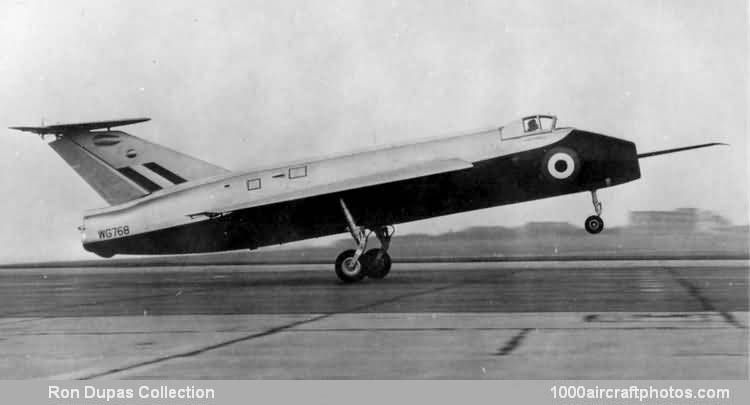01/31/2017. Remarks by Johan Visschedijk: "In view of the large technological step forward which the English Electric P.1A (what became the Lightning) was to make, a low-speed research aircraft was ordered from Short Brothers and Harland at Belfast known as the S.B.5. Intended to provide information on the low-speed characteristics of sharply-swept wing surfaces, it basically had the same shape as the P.1A, but with adjustable sweepback on the mainplanes which could be set at 50°, 60°, and 69°.
The swept-fin and rudder carried a high delta tail plane, whose incidence was controllable from +10° to -10°, with a one-piece elevator hinged to it. The fuselage terminated in a bluff tail, with the jet pipe in the lower half, and braking and anti-spin parachutes in two separate stowages above. The S.B.5 was powered by a single Rolls-Royce Derwent turbojet of 3,600 lb (1,633 kg) thrust and it had a fixed landing gear.
The S.B.5 was first flown with 50° sweep at Boscombe Down by Tom Brooke-Smith on December 2, 1952, and within seven months had completed its initial test schedule without incident. The sweep-angle was then increased to 60°, and in this form it flew on 29 July, 1953, and made its first public appearance at the SBAC show at Farnborough in September. Three months later, the tail plane and elevator, suitably modified, were moved from the top of the fin to the bottom of the rear fuselage; at the same time the inboard leading edges of the wings were modified to a pronounced droop-angle, still with 60° sweep overall. In this form the S.B.5 was first flown at Boscombe Down by Tom Brooke-Smith in January 1954, and the ensuing program occupied over two years there and at RAE Bedford, the results being correlated with the final development of the Lightning supersonic fighter.
In 1957, after considering the possibility of attaching an auxiliary turbojet to improve acceleration from near stall speed, it was decided to install a more compact and powerful Bristol Orpheus in place of the Derwent, concurrently with the final sweep alteration to 69°; at the same time the instrumentation was revised, a zero-level Martin-Baker ejection seat was installed and the aircraft was repainted glossy light blue to enable it to be quickly distinguished from Lightnings of similar appearance but very different performance. The S.B.5 was shipped back to Belfast in 1958 for this quite substantial rebuild and was returned to Bedford in September 1960, the first flight with maximum sweep being made by Denis Tayler of the RAE staff on October 18; thereafter it remained at the disposal of Aero Flight for basic handling trials in comparison with wind-tunnel tests, resulting in a considerable mass of data on scale effect being acquired.
When this program ended the S.B.5 was offered for full-scale experimental purposes to the Australian Aeronautical Research Laboratory, who declined it, and it then went to the Empire Test Pilots' School (ETPS) at Farnborough, where in 1967 it was flown for low-speed familiarization on slender aircraft. By 1969 it had become a ground instruction frame (serialed 8005M) at Finningley, later moving to Cosford for permanent preservation."
